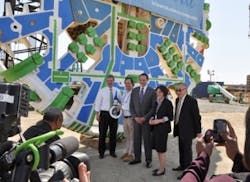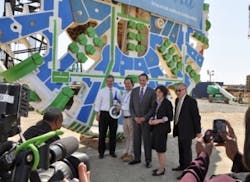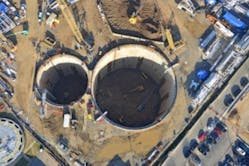WASHINGTON, D.C., April 10, 2013 -- The District of Columbia Water and Sewer Authority (DC Water) named its massive tunnel boring machine (TBM), christened it with DC tap water and prepared to send it underground to tunnel more than four miles along the Potomac at a depth of approximately 100 feet. The machine is more than 400 feet long and weighs more than 1323 tons. It will dig the Blue Plains Tunnel, which is a portion of DC Water's Clean River Project to significantly reduce combined sewer overflows (CSOs) and improve water quality in the District of Columbia.
District of Columbia Mayor Vincent Gray, EPA Regional Administrator Shawn Garvin, DC Councilmember Mary Cheh, DC Water Board of Directors Chairman Allen Lew and DC Water General Manager George S. Hawkins participated in today's event at the Blue Plains Advanced Wastewater Treatment Plant.
"Much like her namesake, 'Lady Bird' will be performing important work for the long-term health of our rivers," said Mr. Hawkins. "This tunnel system will reduce combined sewer overflows into the Anacostia by 98 percent."
As in many older cities, about one-third of the District has a combined sewer system. A CSO occurs during heavy rain when the mixture of sewage and stormwater cannot fit in the sewer pipes and overflows to the nearest water body. CSOs contain bacteria and trash that can be harmful to the environment.
DC Water's plan to significantly reduce CSOs to the Anacostia River is to build massive underground tunnels that will store the combined sewage and runoff during intense rainstorms and then release it when the system has the capacity to treat it. Similar tunnels exist in cities like Chicago, Indianapolis, and Atlanta.
"Earlier this year, I unveiled the Sustainable DC Plan, a 20-year plan to make the District the healthiest, greenest, most livable city in the nation," Mayor Gray said. "The Clean Rivers Project goes a long way to providing sustainability for the region, making our waterways healthier and cleaner."
About DC Water
The District of Columbia Water and Sewer Authority (DC Water), is an industry leading multi-jurisdictional regional utility that provides drinking water, and wastewater collection and treatment for millions of visitors, residents and employees in the District of Columbia, and also collects and treats wastewater for a population of 1.6 million in Montgomery and Prince George's counties in Maryland and Fairfax and Loudoun counties in Virginia.
DC Water's service area covers approximately 725 square miles and the enterprise operates the world's largest advanced wastewater treatment plant with a capacity of 370 million gallons per day and a peak capacity of 1.076 billion gallons per day.
###





